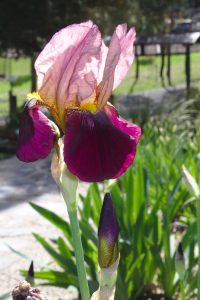Irises: Japanese traditions
 The ancient art of gardening is alive and well at Shizuka Ryokan. Our gardens display a beautiful selection of traditional Japanese plants such as bamboo, ginkgo, persimmon, sakura (cherry blossom), maple, shiso (a herb used in our kitchen), magnolia, Japanese quince and hibiscus. At dusk, the pine trees fill with sulphur-crested cockatoos, and the fruit trees attract fast moving parrots, leaving streaks of the brightest greens and reds. Kangaroos feed on the grass. A kookaburra sits on the wooden bridge at the ryokan entrance, waiting for chef Akiko-san to appear with sashimi. It is this fusion–of Japanese tradition in an Australian setting–that makes a visit to Shizuka Ryokan potent and unique.
The ancient art of gardening is alive and well at Shizuka Ryokan. Our gardens display a beautiful selection of traditional Japanese plants such as bamboo, ginkgo, persimmon, sakura (cherry blossom), maple, shiso (a herb used in our kitchen), magnolia, Japanese quince and hibiscus. At dusk, the pine trees fill with sulphur-crested cockatoos, and the fruit trees attract fast moving parrots, leaving streaks of the brightest greens and reds. Kangaroos feed on the grass. A kookaburra sits on the wooden bridge at the ryokan entrance, waiting for chef Akiko-san to appear with sashimi. It is this fusion–of Japanese tradition in an Australian setting–that makes a visit to Shizuka Ryokan potent and unique.
This month, the Irises are in bloom. In Japan, Iris cultivation is considered a high art, and the Japanese have developed more than 2000 cultivated varieties. These cultivars display large, beautifully coloured and patterned flowers, with exceptional wide falls (the petals that hang down) and narrow standards (the upright petals).
The name Iris comes from the Greek word for rainbow, an apt name for a species that blooms in a wide range of colours. There are around 300 species of Iris. They are treasured for their large flowers—in colours of blue, purple, maroon or white—and their contrasting pattterns of dots, stripes, veins and edges. Many Iris have ruffled flowers, with multiple floral parts.
There are three species of Iris commonly grown in Japan—hanashobu (Iris ensata), kakitsubata (Iris laevigata) and ayame (Iris sanguinea). Outside of Japan, Iris ensata is referred to as ‘Japanese iris’. It has a bluish purple colour and references to it in Japanese art and literature date back to the 12th century. Iris ensata is native to Japan, China, Korea and Siberia. It is believed that farmers would plant irises in or near their rice fields because their blooming coincided with the start of the rainy season—the time for transplanting rice plants from seed beds to the fields.
To learn more we recommend The Japanese Garden, a fantastic book written by Sophie Walker.













